
views
Dyeing the Sheet a Solid Color
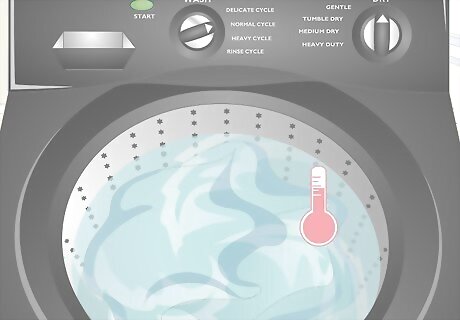
Wash the sheet in hot water without detergent. If your sheet is new, washing it first is essential because otherwise, the new fabric might not accept the dye. However, even if your sheet is older, wash it to remove dirt and oils that might keep the dye from absorbing easily. If there are any large or dark stains on the sheet, soak the material in stain remover to lighten the stain, then wash it in hot water. Do not dry the sheet. It will accept the dye more evenly if it's already wet.

Fill 1/3 of your bathtub with 120–140 °F (49–60 °C) water. Turn your tap onto the hottest setting and let it run for a few minutes. Then, put in the stopper and fill the bathtub about a third of the way. There should be enough water so you can completely submerge your sheet, but if you fill the bathtub with too much water, it will be hard to get the color dye you need. Most household water heaters are set between 120–140 °F (49–60 °C), so the hottest water from your tap should be enough. You'll get better results with hotter water, so if your water heater is set to 120 °F (49 °C), you may want to boil a pot of water on your stove and add it to the bath to bring the temperature up. You can also pour the water into a very large bucket or container. Variation: If you prefer, you can dye your sheet in the washing machine. Just fill the basin with hot water, add the dye and the sheet, and turn off the washing machine cycle. Allow the sheet to soak for 30 minutes, then run your machine as usual to rinse the sheet. When you're finished, wash the sheet again in cold water to set the color.
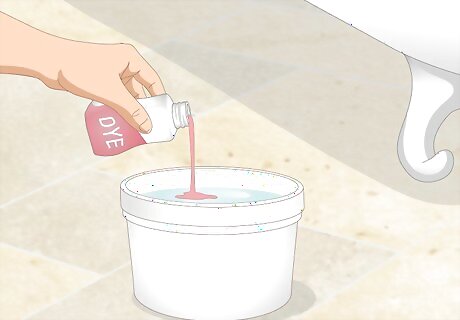
Mix your fabric dye according to the package instructions. The exact way you mix your dye will depend on the brand and the type of dye you're using, but in general, you'll pour the dye into 1–2 cups (240–470 mL) of very hot or boiling water. Doing this will ensure that the dye mixes more evenly when you add it to the bath. A single box of dye should be enough for 1 sheet. However, if you're trying to achieve a very dark or bright color, you can use 2 boxes, if you prefer. Some popular, easy-to-use brands of fabric dye include Tulip, Dylon, and Rit Dye. Don't want to use chemical dye? Try using natural dyes made from plants. For instance, you might use beets for pinkish-red sheets or coffee for a deep tan. While the colors won't be as intense as commercial products, you'll still get beautiful results.
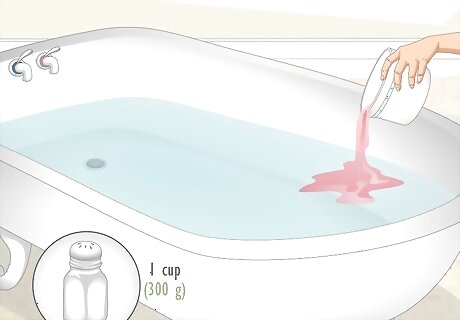
Stir in the dye and 1 cup (300 g) of salt. Once you've mixed your dye, pour it into the hot water in your bathtub or container. Then, add 1 cup (300 g) of table salt to the mixture and stir everything with a long-handled spoon or long stick. The salt will help the dye absorb more evenly. If you're using 2 boxes of dye, add 2 cups (600 g) of salt.Tip: To test the color once it's mixed, dip a paper towel in the dye bath. If the color is too dark, add more water. If it's too light, add more dye.
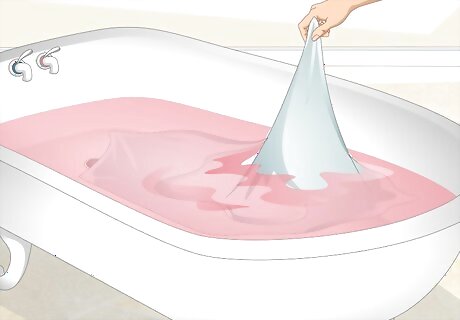
Submerge your sheet in the dye bath and stir continuously. Try not to bunch up the sheet when you place it in the water. Place the sheet into your bathtub, then use your spoon or stick to swish the sheet around in the water. Keep stirring for at least 10 minutes, then stir the sheet again every 3-5 minutes as long as it's in the dye bath. Stirring the sheet ensures there aren't any folds or wrinkles where the dye can't penetrate. It's a good idea to wear long gloves for this so the dye doesn't stain your hands if you accidentally touch it.
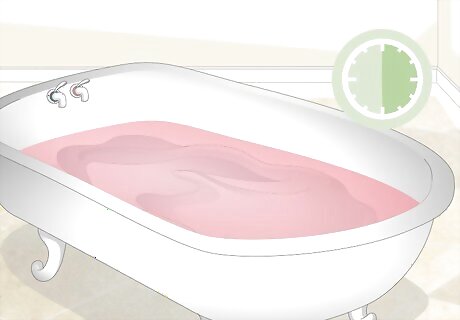
Leave the sheet in the dye for about 30 minutes. To get a rich, vibrant color, you'll probably need to soak your sheet for about half an hour, stirring regularly. However, if you lift the sheet out of the water and you're satisfied with the color before then, it's fine to take it out early. You can also leave the sheet in the water a little longer if you haven't achieved the color you want.

Remove the sheet, wring it out, and drain your bathtub. When you're happy with the color, lift the sheet out of the bathtub and squeeze it to remove as much of the excess dye as possible. Then, remove the stopper from your bathtub so you can rinse the sheet. It might help to have a large plastic container available to put the sheet into after you wring it out. If you're using a washing machine, allow it to continue to the spin cycle.

Rinse the sheet thoroughly in cold water. Hold the sheet under the tap and continue rinsing it until the water runs clear. This may take several minutes, so be patient—it's important to rinse the dye thoroughly. Rinse your bathtub or bucket, as well.
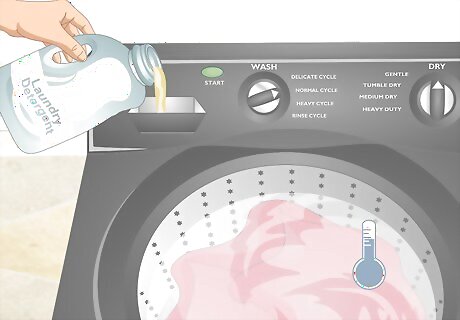
Wash the sheet again with mild detergent and cold water. After you finish rinsing out the excess dye, place your sheet in the washing machine or wash it by hand with cold water and a mild detergent. This will help set the dye and remove any remaining residue. When you're finished, hang the sheet to dry or place it in the dryer. Then, enjoy the new look for your bed, or take your dyed sheet to the beach or on a picnic to show it off! When you wash your sheet for the first time, consider washing it separately from your other clothing, and in cold water. That way, if any of the dye is left, it won't bleed onto your clothes. After that, wash the sheet the way you normally would, but keep in mind that washing in cold water will preserve the color longer.
Tie-Dyeing Your Sheet
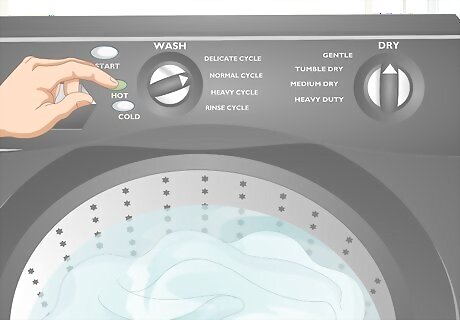
Wash the sheet in hot water, but don't dry it. Your sheet will absorb the dye more evenly if it's clean and wet, so before you try to dye it, run it through the washing machine. Use hot water, but skip the detergent, as this may leave a residue that interferes with the dye. Light-colored sheets made of cotton or rayon are best for this project.
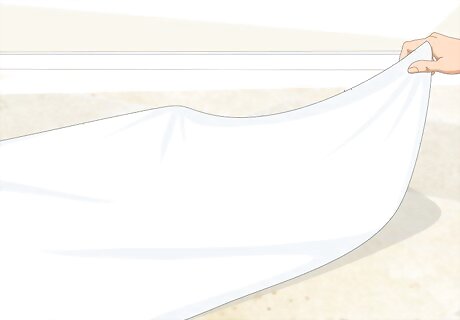
Place a dropcloth or tarp on your workstation. Tie-dyeing can be messy, so to protect your floor, table, or other work surface, it's a good idea to spread out some sort of tarp or dropcloth. If you don't have one on hand, try cutting open 3-4 garbage bags, then spread them across your work area. Tip: To minimize cleanup, wait for a day with nice weather, then spread out a dropcloth on the ground outside and use that as your workspace.
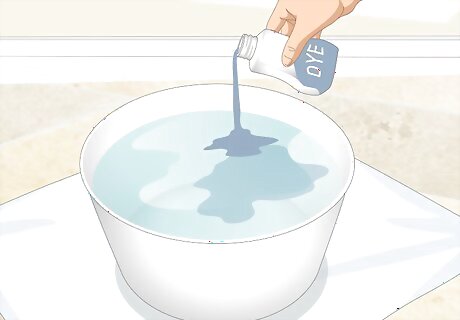
Mix your dye in a bucket according to package directions. The easiest way to tie-dye your sheets is to buy a tie-dye kit, which will come with several different colors of dye, rubber bands, and containers or squeeze bottles. However, if you're mixing up your own dye, follow the package instructions to determine how much water to use for the product you're using. If you're using multiple colors of dye, mix each color in its own container. If the dye package recommends adding salt, do that now. You can also mix the dye and pour into squeeze bottles if you want more control over the process. This is especially helpful if you want to use more than 1-2 colors.
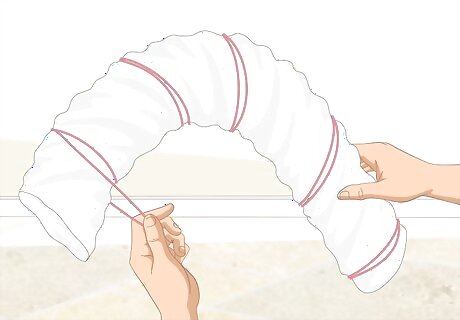
Twist or fold the sheet and secure it with rubber bands. For a traditional tie-dye pattern, grab the center of the sheet, then twist it into a long sphere. Then, wrap rubber bands tightly around the sphere, spacing them about 4–5 in (10–13 cm) apart. To make geometric patterns, fold the sheet into triangles or squares, or pleat it in an accordion shape. Then, criss-cross the rubber bands across that shape. Make smaller circular gathers for a polka-dotted or floral tie-dye.
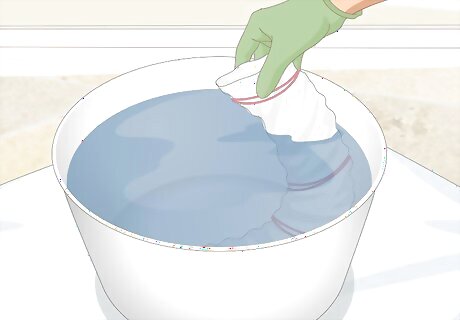
Put on gloves, then dip the sheet into dye. Protect your hands with plastic or rubber gloves, then dip 1 end of the sheet in the dye and hold it there for about 10-15 seconds. If you're only using 1 color, you can submerge the whole sheet in the dye bin. However, if you're using multiple colors, try to dip a different area of the sheet into each color. Either way, try to saturate the sheet fully with the dye. It's okay if the colors bleed into each other somewhat, but try not to overlap them completely or the final result may look muddy. If you're using squirt bottles, squeeze the color out onto the fabric. Try to apply each colors to a different section.

Remove the sheet from the dye and place it in a separate container for 20 minutes. In order for the dye to soak deep into the twists and folds that you created, you'll need to let the sheet rest undisturbed. Place the dyed fabric in a plastic bin, container, or bag, and wait about 20 minutes or so. Make sure you choose a container that's okay to dye, since it may become stained.
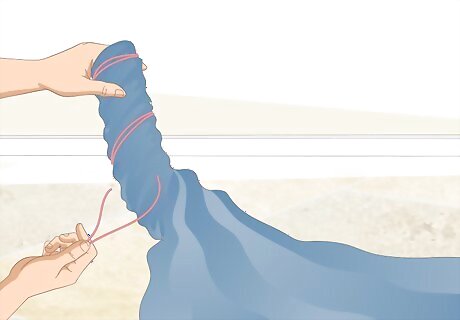
Remove the rubber bands and unfold the sheet. After the dye has soaked into the sheet, unwrap or cut away the rubber bands, then hold your sheet up and admire your work! Although the color may bleed a little when you rinse it, the final result won't change much from what you see now.
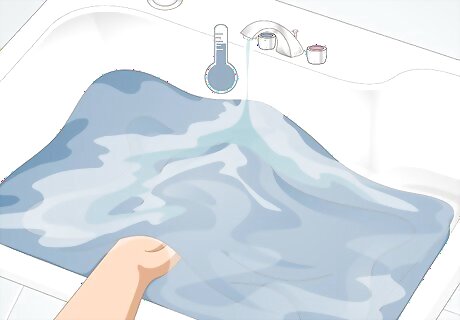
Rinse your sheet in cold water until the water runs clear. Hold the sheet under cold running water and rinse out any excess dye. Keep rinsing the sheet until the water runs completely clear. Otherwise, the sheet may bleed the next time you wash it. The cold water will help set the dye. When you're finished, hang the sheet up to air dry or place it in the dryer. The first time you wash the sheet, it may be a good idea to wash it in cold water, separate from your other clothes, in case any of the dye still remains. After that, however, it should be fine to wash with like colors. You can use whatever water temperature you typically prefer for your bedding, although washing the sheet in cold water will keep the colors vibrant longer.




















Comments
0 comment